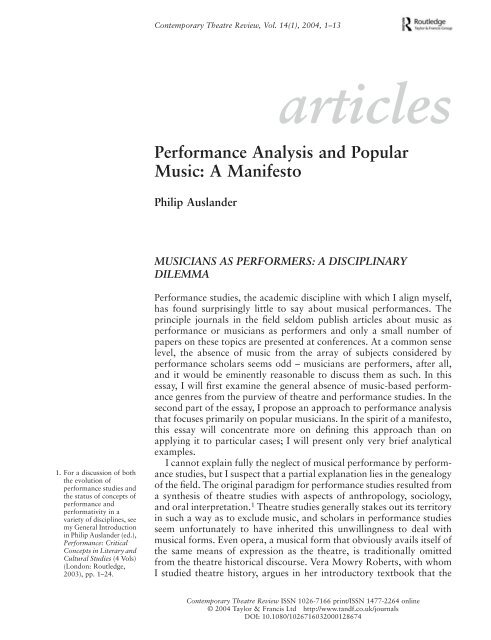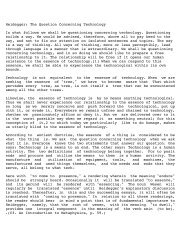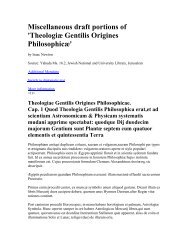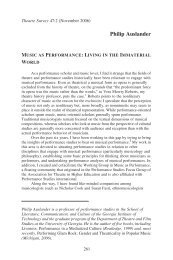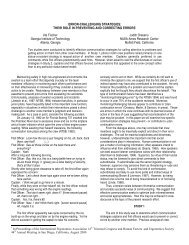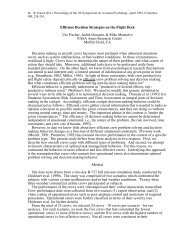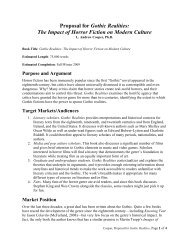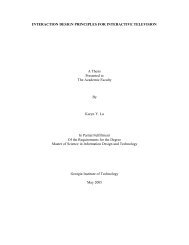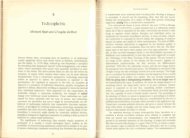Performance Analysis and Popular Music: A Manifesto
Performance Analysis and Popular Music: A Manifesto
Performance Analysis and Popular Music: A Manifesto
You also want an ePaper? Increase the reach of your titles
YUMPU automatically turns print PDFs into web optimized ePapers that Google loves.
1. For a discussion of both<br />
the evolution of<br />
performance studies <strong>and</strong><br />
the status of concepts of<br />
performance <strong>and</strong><br />
performativity in a<br />
variety of disciplines, see<br />
my General Introduction<br />
in Philip Ausl<strong>and</strong>er (ed.),<br />
<strong>Performance</strong>: Critical<br />
Concepts in Literary <strong>and</strong><br />
Cultural Studies (4 Vols)<br />
(London: Routledge,<br />
2003), pp. 1–24.<br />
Contemporary Theatre Review, Vol. 14(1), 2004, 1–13<br />
articles<br />
<strong>Performance</strong> <strong>Analysis</strong> <strong>and</strong> <strong>Popular</strong><br />
<strong>Music</strong>: A <strong>Manifesto</strong><br />
Philip Ausl<strong>and</strong>er<br />
MUSICIANS AS PERFORMERS: A DISCIPLINARY<br />
DILEMMA<br />
<strong>Performance</strong> studies, the academic discipline with which I align myself,<br />
has found surprisingly little to say about musical performances. The<br />
principle journals in the field seldom publish articles about music as<br />
performance or musicians as performers <strong>and</strong> only a small number of<br />
papers on these topics are presented at conferences. At a common sense<br />
level, the absence of music from the array of subjects considered by<br />
performance scholars seems odd – musicians are performers, after all,<br />
<strong>and</strong> it would be eminently reasonable to discuss them as such. In this<br />
essay, I will first examine the general absence of music-based performance<br />
genres from the purview of theatre <strong>and</strong> performance studies. In the<br />
second part of the essay, I propose an approach to performance analysis<br />
that focuses primarily on popular musicians. In the spirit of a manifesto,<br />
this essay will concentrate more on defining this approach than on<br />
applying it to particular cases; I will present only very brief analytical<br />
examples.<br />
I cannot explain fully the neglect of musical performance by performance<br />
studies, but I suspect that a partial explanation lies in the genealogy<br />
of the field. The original paradigm for performance studies resulted from<br />
a synthesis of theatre studies with aspects of anthropology, sociology,<br />
<strong>and</strong> oral interpretation. 1 Theatre studies generally stakes out its territory<br />
in such a way as to exclude music, <strong>and</strong> scholars in performance studies<br />
seem unfortunately to have inherited this unwillingness to deal with<br />
musical forms. Even opera, a musical form that obviously avails itself of<br />
the same means of expression as the theatre, is traditionally omitted<br />
from the theatre historical discourse. Vera Mowry Roberts, with whom<br />
I studied theatre history, argues in her introductory textbook that the<br />
Contemporary Theatre Review ISSN 1026-7166 print/ISSN 1477-2264 online<br />
© 2004 Taylor & Francis Ltd http://www.t<strong>and</strong>f.co.uk/journals<br />
DOI: 10.1080/1026716032000128674
2<br />
2. Vera Mowry Roberts,<br />
On Stage: A History of<br />
Theatre, 2nd edn (New<br />
York: Harper <strong>and</strong> Row,<br />
1974), p. 108.<br />
3. Patrice Pavis, L’Analyse<br />
des spectacles (Paris:<br />
Editions Nathan, 1996),<br />
p. 121.<br />
4. Anthony Tommasini,<br />
‘Bravos At Opera Are<br />
Expected, But Booing?’,<br />
New York Times<br />
(1 February 2003),<br />
pp. A19, A24.<br />
history of opera <strong>and</strong> the history of theatre are separate narratives<br />
because ‘the predominant force in opera was the music rather than the<br />
words’ <strong>and</strong> ‘the composer . . . is the focus of attention in opera’. 2 For<br />
Roberts, the fact that opera is driven by music rather than drama, by<br />
composers rather than playwrights, places it outside the realm of theatre<br />
history.<br />
Scholars whose primary concern is with analyzing performances,<br />
whom one might expect to be more open to the nonliterary aspects of<br />
performance, are no more willing than traditional theatre historians to<br />
bring opera into the fold. As sophisticated a performance analyst as<br />
Patrice Pavis more or less throws in the towel when it comes to this form,<br />
arguing that whereas it is possible to analyze theatrical performances by<br />
breaking them down into their component parts, opera dem<strong>and</strong>s a<br />
radically different ‘fusional’ approach:<br />
L’opéra, malgré la richesse et la diversité de ses sources, se prête mal à une<br />
dissection et à une énumération de ses matériaux. Car cette matière, sous<br />
l’influence du rhythme musical et gestuel, a déjà fusionné, mêlant et<br />
fondant ce qui semblait s’opposer: la parole et la musique, l’espace et le<br />
temps, the voix et le corps, le processus et la stase. 3<br />
(Despite the richness <strong>and</strong> diversity of opera’s signs <strong>and</strong> sources, it lends<br />
itself poorly to an enumeration of its materials. Under the influence of<br />
musical <strong>and</strong> gestural rhythm, these elements have fused, mixing <strong>and</strong><br />
melding together what seem to be opposing elements: speech <strong>and</strong> music,<br />
time <strong>and</strong> space, the voice <strong>and</strong> the body, movement <strong>and</strong> stasis.)<br />
Although Pavis is not concerned as Roberts is with the specifically nonliterary<br />
character of music, he does consider music to be a non-mimetic<br />
form whose representations do not refer directly back to the real world.<br />
He therefore feels that music confounds the very categories upon which<br />
successful analysis of theatrical events depends.<br />
It would be grossly unfair, however, to chastise theatre <strong>and</strong> performance<br />
scholars for being reluctant to engage with musical forms without<br />
also pointing out that both academic musicologists <strong>and</strong> serious fans of<br />
classical music are traditionally uninterested in performance as an object<br />
of analysis. When attending a performance at the Metropolitan Opera<br />
House in New York City, for instance, one can sit at a score desk, ‘one<br />
of the side seats on the top balcony where the view is obstructed but you<br />
can follow the printed score at a small table with a dim lamp’. 4 Granted<br />
that the score desk may be a way of deriving income from otherwise<br />
uninhabitable realms of the opera house, it nevertheless reifies a mode<br />
of spectatorship that is unimaginable from the theatrical point of view.<br />
No serious theatre scholar or theatre-goer would consider the opportunity<br />
to read a play while listening to actors perform it to be compensation<br />
for not being able to see the performance. The score desk is an<br />
artifact of the traditional perception of music described by Christopher<br />
Small, a way of thinking that locates ‘the essence of music <strong>and</strong> of<br />
whatever meanings it contains . . . in those things called musical works<br />
. . .’ not in performances of those works. This perspective rests on the<br />
premise ‘that musical performance plays no part in the creative process,
5. Christopher Small,<br />
<strong>Music</strong>king: The<br />
Meanings of Performing<br />
<strong>and</strong> Listening (London:<br />
Wesleyan University<br />
Press, 1998), pp. 4–5.<br />
6. Theodore Gracyk,<br />
Rhythm <strong>and</strong> Noise: An<br />
Aesthetics of Rock<br />
(Durham: Duke<br />
University Press, 1996),<br />
p. 75.<br />
7. Lawrence Grossberg,<br />
‘Reflections of a<br />
Disappointed <strong>Popular</strong><br />
<strong>Music</strong> Scholar’, in Roger<br />
Beebe, Denise Fulbrook<br />
<strong>and</strong> Ben Saunders (eds),<br />
Rock over the Edge:<br />
Transformations in<br />
<strong>Popular</strong> <strong>Music</strong> Culture,<br />
(Durham: Duke<br />
University Press, 2002),<br />
pp. 25–59 (p. 49).<br />
being only the medium through which the isolated, self-contained work<br />
has to pass in order to reach its goal, the listener’. 5<br />
Small attributes this conservative view of music to traditional<br />
historians of music <strong>and</strong> musicologists, but one encounters dismissals of<br />
musical performance as an object of primary concern in other disciplines<br />
as well, even with respect to popular music. Philosopher Theodore<br />
Gracyk, for instance, argues that because rock music’s primary existence<br />
is in recordings, it ‘is not essentially a performing art, however much<br />
time rock musicians spend practicing on their instruments or playing<br />
live’. 6 Gracyk challenges traditional musicology by arguing that, in rock,<br />
recordings, not compositions, are the primary musical works, but his<br />
challenge privileges the recording in a way that parallels musicology’s<br />
privileging of the score. Lawrence Grossberg, a major figure in cultural<br />
studies, takes a broadly similar position by claiming that live performances<br />
of rock are at most secondary iterations of a work contained in<br />
the recording: ‘The performative side of rock seems to be simply another<br />
occasion, another activity, with no privilege beyond that of a night on<br />
the town, a potentially good time’. 7 For Gracyk <strong>and</strong> Grossberg, performances<br />
of rock may function as social lubricants but are inessential<br />
manifestations of the music with no inherent aesthetic or cultural value.<br />
Perhaps because of its roots in sociology <strong>and</strong> ethnography, the field<br />
of cultural studies generally emphasizes the reception of popular music<br />
much more than the performance behavior of musicians. Although<br />
scholars in communications <strong>and</strong> cultural studies often make excellent<br />
observations concerning specific genres of rock <strong>and</strong> pop music, their<br />
remarks on performance are generally impressionistic <strong>and</strong> synoptic.<br />
Most of the work in cultural studies of popular music that focuses on<br />
production examines the sociological, institutional, <strong>and</strong> policy contexts<br />
in which popular music is made, not the immediate context of the work<br />
of the artists who make it. In contrast, my stance here is unabashedly<br />
performer-centered: I am interested primarily in finding ways of<br />
discussing what popular musicians do as performers – the meanings they<br />
create through their performances <strong>and</strong> the means they use to create<br />
them. Although I will not ignore the reception of these performances, I<br />
am less concerned with the audience than with the performers themselves.<br />
This, then, is what I am choosing to call the disciplinary dilemma<br />
confronting the scholar who wishes to talk seriously about musicians as<br />
performers: those who take music seriously, either as art or culture,<br />
dismiss performance as irrelevant. Those who take performance<br />
seriously are reluctant to include musical forms among their objects of<br />
study. I hope that as a scholar in performance studies with a lifelong,<br />
passionate interest in popular music I can make a small contribution to<br />
bridging the divide between the study of music <strong>and</strong> the study of performance<br />
by encouraging close readings of performances by popular musicians,<br />
readings that attend to the particulars of physical movement,<br />
gesture, costume, <strong>and</strong> facial expression as much as voice <strong>and</strong> musical<br />
sound.<br />
The good news is that there are scholars in musicology <strong>and</strong> cultural<br />
studies who are also interested in bridging this gap. Three recent books<br />
3
4<br />
8. Small, <strong>Music</strong>king, p. 8.<br />
Philosopher Stan<br />
Godlovitch adopts the<br />
same perspective on<br />
classical music in his<br />
<strong>Music</strong>al <strong>Performance</strong>: A<br />
Philosophical Study<br />
(London: Routledge,<br />
1998).<br />
9. Pavis charts the rise <strong>and</strong><br />
fall of theatrical<br />
semiotics as well as the<br />
current eclecticism in<br />
performance analysis<br />
(L’Analyse, pp. 13–30).<br />
This list of contributing<br />
disciplines draws on<br />
Pavis <strong>and</strong> the authors<br />
represented in Colin<br />
Counsell <strong>and</strong> Laurie<br />
Wolf (eds), <strong>Performance</strong><br />
<strong>Analysis</strong>: An<br />
Introductory<br />
Coursebook (London:<br />
Routledge, 2001).<br />
that argue explicitly for seeing musical performance as performance<br />
st<strong>and</strong> out as exemplary <strong>and</strong> I have drawn on all three in this essay. Simon<br />
Frith’s Performing Rites: On the Value of <strong>Popular</strong> <strong>Music</strong> (1996) provides<br />
a framework for thinking about popular music as performance in the<br />
disciplinary context of cultural studies. In <strong>Music</strong>king: The Meanings of<br />
Performing <strong>and</strong> Listening (1998), Christopher Small confronts traditional<br />
musicology with a performer-centered account of classical music,<br />
declaring: ‘performance does not exist in order to present musical works,<br />
but rather, musical works exist in order to give performers something to<br />
do’. 8 Small characterizes musical works as actions undertaken by<br />
musicians rather than works written by composers <strong>and</strong> breaks a model<br />
symphony performance down into its component parts (pace Pavis!) to<br />
examine how each contributes to the overall event <strong>and</strong> its social meanings.<br />
Susan Fast, in her book-length study of Led Zeppelin’s music, In<br />
the Houses of the Holy: Led Zeppelin <strong>and</strong> the Power of Rock <strong>Music</strong><br />
(2001) successfully integrates musicology, cultural studies, <strong>and</strong> performance<br />
studies. Fast brings concepts <strong>and</strong> approaches from all three fields<br />
to bear on Led Zeppelin, combining formal musicological analysis of<br />
their compositions with analysis of their performances in all media, the<br />
ideological <strong>and</strong> social issues raised by their music, <strong>and</strong> ethnographic<br />
work on their audiences. Drawing on these scholars, I will outline an<br />
approach to discussing popular music as performance modeled to a large<br />
extent on my own experience as a fan of rock music.<br />
PERFORMANCE ANALYSIS AND POPULAR MUSIC<br />
While theatre scholars have long described <strong>and</strong> analyzed performances,<br />
the idea that performance analysis constitutes an identifiable – though<br />
not strictly defined – approach (as distinct from theatre criticism, say) is<br />
of relatively recent vintage. <strong>Performance</strong> analysis differs from the transcription<br />
methods of ethnomusicologists <strong>and</strong> the notation methods of<br />
dance scholars in the sense that it is as much interpretive as descriptive<br />
<strong>and</strong> is not organized around a specific technical vocabulary. Whereas<br />
dance notation may be of equal value to analysts <strong>and</strong> performers,<br />
performance analysis is understood to be specifically from the spectator’s<br />
point of view. Theatre scholars’ flirtation with the technical vocabulary<br />
of semiotics, popular during the 1970s, has largely dissipated in favor<br />
of a less ‘scientific’, more eclectic set of approaches drawn from reception<br />
theory, phenomenology, cultural anthropology, sociology, feminist<br />
theory, cultural <strong>and</strong> literary theory, <strong>and</strong> other orientations. 9<br />
As the title page of Pavis’ L’Analyse des spectacles (<strong>Performance</strong><br />
<strong>Analysis</strong>) makes abundantly clear, the practice of performance analysis<br />
is geared primarily toward genres of performance in the theatrical<br />
tradition: the list of performance genres under the title includes theatre,<br />
mime, dance, dance-theatre, <strong>and</strong> film but no kind of musical performance,<br />
including musical theatre (I have already noted Pavis’s reasons for<br />
excluding opera). This exclusion notwithst<strong>and</strong>ing, I shall argue here that<br />
musical performances should be seen as legitimate objects of performance<br />
analysis. I will limit my comments to popular music, though I will
10. Pavis, L’Analyse,<br />
pp. 39–42.<br />
11. Susan Fast, In the<br />
Houses of the Holy:<br />
Led Zeppelin <strong>and</strong> the<br />
Power of Rock <strong>Music</strong><br />
(Oxford: Oxford<br />
University Press, 2001),<br />
p. 114.<br />
12. Simon Frith,<br />
Performing Rites: On<br />
the Value of <strong>Popular</strong><br />
<strong>Music</strong> (Cambridge,<br />
MA: Harvard<br />
University Press, 1996),<br />
p. 211. Frith’s<br />
suggestion that listeners<br />
mentally produce the<br />
aspects of performance<br />
not present in sound<br />
recordings is<br />
comparable to<br />
Wolfgang Iser’s notion<br />
that because literary<br />
texts are radically<br />
incomplete in<br />
themselves, the act of<br />
reading consists of<br />
filling in the gaps of the<br />
text. See the excerpt<br />
from Iser’s The Act of<br />
Reading A Theory of<br />
Aesthetic Response, in<br />
Counsell <strong>and</strong> Wolf,<br />
<strong>Performance</strong> <strong>Analysis</strong>,<br />
pp. 179–185.<br />
also indicate briefly ways that much of what I have to say applies to the<br />
performance of jazz, classical music, <strong>and</strong> other genres.<br />
A discussion of how to analyze popular music as performance must<br />
begin with the question of what will count as a performance in this<br />
context. Pavis asserts that only live theatrical performances are<br />
appropriate objects of analysis, that the performance analyst should use<br />
photographs or recordings of performances only as additional documentation<br />
of the original live events. 10 If applied to the realm of popular<br />
music, this stipulation would bring performance analysis to a grinding<br />
halt, for recordings are the primary form in which the audience<br />
consumes popular music. The media economy of popular music thus<br />
dictates that sound recordings be considered performances, which is<br />
how listeners experience them.<br />
Despite the physical absence of the performer at the time of listening,<br />
listeners do not perceive recorded music as disembodied. ‘In my view,’<br />
writes Susan Fast, ‘the performer’s body is very much present, in the<br />
particular sonoric gestures shaped <strong>and</strong> played in the first instance by him<br />
or her (they are human gestures, after all) through his or her body in<br />
such a way that they connect with the bodies of those listening.’ 11<br />
Perhaps that is why people often feel compelled to respond to recorded<br />
music by moving or dancing, singing along, or playing air guitar: the<br />
bodily gestures encoded in the recorded sound seem to dem<strong>and</strong> an<br />
embodied response. Regardless of the ontological status of recorded<br />
music, its phenomenological status for listeners is that of a performance<br />
unfolding at the time <strong>and</strong> in the place of listening. Sound recordings of<br />
musical performances should therefore be considered legitimate objects<br />
for performance analysis – especially in light of the privilege it grants to<br />
the spectator’s experience – alongside live musical performances, documentation<br />
of live performances, <strong>and</strong> music videos.<br />
Although the listener both hears <strong>and</strong> feels recorded music as<br />
embodied, the experience of recorded music is not confined to the<br />
auditory <strong>and</strong> haptic senses. As Simon Frith points out, it is also a visual<br />
experience:<br />
to hear music is to see it performed, on stage, with all the trappings. I<br />
listen to records in the full knowledge that what I hear is something that<br />
never existed, that never could exist, as a ‘performance’, something<br />
happening in a single time <strong>and</strong> space; nevertheless, it is now happening,<br />
in a single time <strong>and</strong> space: it is thus a performance <strong>and</strong> I hear it as one<br />
[<strong>and</strong>] imagine the performers performing. . . . 12<br />
The experience of recorded music as performance derives not only from<br />
our direct somatic experience of the sound <strong>and</strong> our sense of the physical<br />
gestures the musicians made to produce it but also from various forms<br />
of cultural knowledge, including knowledge of the performance conventions<br />
of particular genres of music <strong>and</strong> the performance styles of specific<br />
performers. As an audience, we acquire these kinds of knowledge from<br />
our experience of live performances <strong>and</strong> the visual culture that<br />
surrounds popular music.<br />
Having argued in favor of considering musical performances in these<br />
various media as legitimate objects of analysis, I will offer some<br />
5
6<br />
13. Frith, Performing Rites,<br />
pp. 186, 212.<br />
14. Frith uses the term<br />
persona but only in<br />
reference to<br />
performance artists<br />
who ‘took themselves<br />
<strong>and</strong> their bodies as the<br />
objects or sites of<br />
narrative <strong>and</strong> feeling’<br />
(Frith, Performing<br />
Rites, p. 205) not in<br />
reference to popular<br />
musicians. I find the<br />
term persona useful as a<br />
way of describing a<br />
performed presence that<br />
is not a character (in the<br />
usual sense) but also is<br />
not quite equivalent to<br />
the performer’s ‘real’<br />
identity.<br />
15. Richard Schechner,<br />
‘Performers <strong>and</strong><br />
Spectators Transported<br />
<strong>and</strong> Transformed’, The<br />
Kenyon Review, New<br />
Series, 3: 4 (Fall 1981),<br />
83–113 (p. 88).<br />
suggestions of how to analyze them, beginning with the performers<br />
themselves. We may not usually think of musical performance, apart<br />
from opera <strong>and</strong> musical theatre, as entailing characterization in the<br />
conventional dramatic sense. Nevertheless, we must be suspicious of any<br />
supposition that musicians are simply ‘being themselves’ on stage. Frith<br />
helpfully identifies three different strata in popular musicians’ performances,<br />
all of which may be present simultaneously. Frith proposes that<br />
we hear pop singers as ‘personally expressive’, that is, as singing in their<br />
own persons, from their own experience. But two other layers are<br />
imposed on that one because popular musicians are ‘involved in a<br />
process of double enactment: they enact both a star personality (their<br />
image) <strong>and</strong> a song personality, the role that each lyric requires, <strong>and</strong> the<br />
pop star’s art is to keep both acts in play at once’. 13 In this respect, Frith<br />
rightly suggests that pop singers are more like film actors than stage<br />
actors since film actors also perform both their own star personalities<br />
<strong>and</strong> the characters they portray.<br />
I shall both systematize <strong>and</strong> exp<strong>and</strong> on Frith’s account. From this<br />
point on, I will refer to the three layers of performance he identifies as<br />
the real person (the performer as human being), the performance<br />
persona (which corresponds to Frith’s star personality or image) <strong>and</strong> the<br />
character (Frith’s song personality). 14 All three layers may be active<br />
simultaneously in a given musical performance. For example, when<br />
Kelly Clarkson, the winner of the 2002 American Idol television singing<br />
competition, sang a duet on television with country singer Reba<br />
McIntyre, they performed a song in which they played the roles of<br />
women competing for the affection of the same man. In addition to these<br />
characters, however, they also portrayed musical personae of the<br />
seasoned veteran singer <strong>and</strong> her young acolyte (<strong>and</strong> perhaps future<br />
competitor); these personae were delineated through the same performance<br />
as the characters in the song but were independent of those<br />
characters – the singers could have performed their personae regardless<br />
of what song they chose. The presence of the performers as real people<br />
was implied through Clarkson’s televised announcement that she had<br />
always idolized McIntyre <strong>and</strong> had therefore chosen her as her duet<br />
partner when she was in the position to do so by virtue of having won<br />
the competition. Whether true or not, this appeal to personal experience<br />
was layered into the performance alongside the two women’s performance<br />
personae as seasoned veteran <strong>and</strong> young up-<strong>and</strong>-comer <strong>and</strong> their<br />
characters as romantic rivals; all three levels of personification contributed<br />
to the performance’s meaning for the audience.<br />
That these three signified presences admittedly are often difficult to<br />
distinguish from one another does not diminish their heuristic value. The<br />
demarcation line between real person <strong>and</strong> persona is always ambiguous<br />
in performance for, as Richard Schechner points out, performance is<br />
always a matter of the performer’s not being himself but also not not<br />
being himself. 15 This logic of the double negative is represented in one<br />
way by the professional names sometimes used by pop music<br />
performers, names that initially designate their personae but are later<br />
generalized to the real people. David Jones renamed himself David<br />
Bowie; David Bowie is not David Jones, yet he also is not not David
16. Fast, Houses, p. 149.<br />
17. D. A. Pennebaker (dir.),<br />
Ziggy Stardust <strong>and</strong> the<br />
Spiders from Mars: The<br />
Motion Picture (1982).<br />
Jones, as suggested by the fact that the name David Bowie belongs now<br />
to both the real person <strong>and</strong> the performance persona. The real person is<br />
the dimension of performance to which the audience has the least direct<br />
access, since the audience generally infers what the performer is like as<br />
a real person from his performance persona <strong>and</strong> the characters he<br />
portrays. Public appearances off-stage do not give reliable access to the<br />
performer as a real person since it is quite likely that interviews <strong>and</strong> even<br />
casual public appearances are manifestations of the performer’s persona<br />
rather than the real person.<br />
Both the line between real person <strong>and</strong> performance persona <strong>and</strong> the<br />
line between persona <strong>and</strong> character may be blurry <strong>and</strong> indistinct, especially<br />
in the case of pop music performers whose work is heavily autobiographical.<br />
Even in the absence of overt autobiography, however, these<br />
relationships can be complex <strong>and</strong> ambiguous. Bowie has constructed a<br />
number of other identities for himself over the course of his career, many<br />
of which have names of their own: Ziggy Stardust, Aladdin Sane, The<br />
Thin White Duke, etc. It is not entirely clear whether it makes most sense<br />
to see these named entities as characters Bowie plays <strong>and</strong> the Bowie<br />
identity as the persona that remains constant across these representations,<br />
or to see them as transformations of the Bowie persona itself.<br />
Because Ziggy Stardust <strong>and</strong> the others figure primarily as characters in<br />
songs, <strong>and</strong> also because the Bowie persona is that of a performer who<br />
can transform himself completely at a moment’s notice, I would argue<br />
for the former analysis, though the other argument is credible.<br />
I will qualify this schema for popular music performance by indicating<br />
that character is an optional element that comes in primarily when the<br />
musician is a singer performing a song that defines a character textually.<br />
In other cases, the performance may be perceived as a direct performance<br />
of persona unmediated by character. This is particularly true for nonsinging<br />
musicians who do not develop characters through voice <strong>and</strong><br />
lyrics but whose personae may play roles in other kinds of staged<br />
narratives. In her analysis of Led Zeppelin’s performances, Fast points<br />
out that guitarist Jimmy Page played the role of the inspirational musical<br />
genius while bassist <strong>and</strong> keyboard player John Paul Jones portrayed the<br />
persona of the b<strong>and</strong>’s solid, learned musical technician. 16 The interplay<br />
between the two musicians was based partly around this narrative, a<br />
narrative that did not derive from a text such as a song <strong>and</strong> involved the<br />
musicians’ performance personae rather than characters. In another,<br />
more overtly scripted, example from the documentary film of David<br />
Bowie’s Ziggy Stardust <strong>and</strong> the Spiders from Mars concert, guitarist<br />
Mick Ronson seems to assault Trevor Bolder, the bass player, during a<br />
lengthy guitar solo performed as part of the song ‘Width of a Circle’. In<br />
the course of the scuffle, Bolder apparently knocks Ronson onto his<br />
back; after playing in that position for a bit, Ronson gets back up, fends<br />
off the bassist, <strong>and</strong> raises his arms in triumph in the style of professional<br />
wrestler. 17 This melodrama was presumably a choreographed, fictional<br />
battle <strong>and</strong> not a spontaneous fight between the two musicians; as such,<br />
it did not involve the characters of the song (<strong>and</strong> was not enacted by the<br />
singer) but was played out between the two men’s performance personae<br />
as instrumentalists.<br />
7
8<br />
18. For a discussion of the<br />
conductor as performer,<br />
see Small, <strong>Music</strong>king,<br />
pp. 78–86. Godlovitch<br />
argues for what he calls<br />
the ‘personalist’ view of<br />
classical music soloists<br />
according to which the<br />
onstage behavior <strong>and</strong><br />
mannerisms of the<br />
performer are essential<br />
components of the<br />
aesthetic experience of<br />
the music (<strong>Music</strong>al<br />
<strong>Performance</strong>,<br />
pp. 140–142).<br />
The idea that instrumentalists enact personae in narratives suggests<br />
how this basic schema might be extended beyond the realm of rock or<br />
popular music, since musicians <strong>and</strong> musical groups in all genres can be<br />
said to have performance personae. Jazz musicians often have very<br />
distinctive personalities as instrumentalists <strong>and</strong> b<strong>and</strong>leaders, expressed<br />
not only in the way they play but in their appearance, the way they<br />
move, the way they address the audience, <strong>and</strong> the way they deal with<br />
their fellow musicians. During a visit to New York City jazz clubs in<br />
2001, I saw performances by two tenor saxophonists <strong>and</strong> b<strong>and</strong>leaders:<br />
Pharaoh S<strong>and</strong>ers, a veteran of the jazz experimentalism of the 1960s,<br />
<strong>and</strong> Joe Lovano, who came to prominence more recently. S<strong>and</strong>ers,<br />
dressed in a light-colored Nehru suit, presented himself as a beatific elder<br />
statesman who drifted in <strong>and</strong> out of the performance, seemingly picking<br />
up its flow when the mood seemed right. At the end of the set, he invited<br />
the audience to participate in a sing-along on a spiritual theme; holding<br />
out the microphone for responses, he seemed completely unfazed when<br />
no one in the audience replied – he was absorbed in the moment <strong>and</strong><br />
nothing else mattered. Lovano, like the rest of his group, dressed in a<br />
jacket <strong>and</strong> tie, conversed <strong>and</strong> joked with his b<strong>and</strong> mates <strong>and</strong> the audience,<br />
establishing a generally upbeat, informal atmosphere that was<br />
quite different from the reverential tone of S<strong>and</strong>ers’ performance <strong>and</strong><br />
that also belied the rigors of the hard bop Lovano <strong>and</strong> his b<strong>and</strong> were<br />
playing. Lovano also seemed to be more a working member of an<br />
ensemble than the relatively aloof S<strong>and</strong>ers, who remained to the side or<br />
off-stage during substantial portions of the set. The personae these<br />
musicians performed may have some relationship to their off-stage<br />
personalities <strong>and</strong> values; audiences may in fact be eager to believe that<br />
they do. But this does not mean, once again, that S<strong>and</strong>ers <strong>and</strong> Lovano<br />
were simply ‘being themselves’ on stage. Other jazz musicians, notably<br />
the members of the Art Ensemble of Chicago <strong>and</strong> Sun Ra’s Arkestra,<br />
have performed obviously constructed <strong>and</strong> artificial personae to demonstrate<br />
that jazz performance personae need not be identical with the<br />
musicians’ identities as human beings.<br />
My analytical schema applies as well to the performance of classical<br />
music. Symphony orchestra conductors have performance personae<br />
(e.g., the authoritarian conductor, the dignified, patrician conductor, the<br />
conductor as a passionate, Romantic figure, <strong>and</strong> so on) as do singers <strong>and</strong><br />
instrumental solotists. 18 Even a classical music ensemble can have a<br />
collective persona. A particular orchestra may assume a persona so<br />
conservative that its audience’s jaws drop if a 20th-century composition<br />
appears on one of its programs, while the members of a string quartet<br />
may take on the performance personae of youthful mavericks who<br />
behave more like pop stars than staid classical musicians. Symphonic<br />
musicians rarely portray characters through their playing, but it can<br />
happen, as when the instruments represent various animal <strong>and</strong> human<br />
characters in Prokofiev’s Peter <strong>and</strong> the Wolf or Saint-Saëns’s The<br />
Carnival of the Animals.<br />
Other elements of rock <strong>and</strong> pop musicians’ performances align with<br />
their performance personae more than with their characters. <strong>Music</strong>ians’<br />
costumes, make-up, <strong>and</strong> general appearance, along with any sets,
19. See Simon Frith <strong>and</strong><br />
Angela McRobbie,<br />
‘Rock <strong>and</strong> Sexuality’, in<br />
Simon Frith <strong>and</strong><br />
Andrew Goodwin (eds),<br />
On Record: Rock, Pop<br />
& the Written Word<br />
(London: Routledge,<br />
1990), pp. 371–389<br />
(p. 372).<br />
lighting, props (including musical instruments), <strong>and</strong> visual effects they<br />
may use, usually express their personae, which remain continuous<br />
throughout a performance <strong>and</strong> across their performances, not the individual<br />
characters they may portray from song to song. Fast borrows<br />
Eugenio Barba’s description of the actor as possessing a ‘fictional body’<br />
<strong>and</strong> applies it to musicians; it seems to me that the fictional body of a<br />
musical performer is the body of his performance persona, a body whose<br />
appearance is made to conform to the image of that persona.<br />
Although this is a large issue that I cannot treat fully here, it is worth<br />
mentioning that a musical artist’s performance persona is not necessarily<br />
static: it may evolve over time to adapt to changing fashions <strong>and</strong> cultural<br />
trends. The Beatles’ personae in 1963, when they were basically an<br />
incredibly talented <strong>and</strong> successful boy b<strong>and</strong>, were quite different from<br />
their personae in 1968, when they were considered serious countercultural<br />
rock artists. When <strong>and</strong> how quickly a performer’s persona may<br />
evolve, if at all, <strong>and</strong> in what directions, are subject to delicate negotiations<br />
with the audience. Miscalculation can result in anything from a<br />
temporary setback to the end of a performing career, though the<br />
performer’s only alternative often is to freeze a popular persona in the<br />
hope of retaining the loyalty of its original audience (this is what<br />
performers on the oldies concert circuits must do).<br />
<strong>Popular</strong> musicians do not perform their personae exclusively in live<br />
<strong>and</strong> recorded performances; they perform them as well through the<br />
visual images used in the packaging of recordings, publicity materials,<br />
interviews <strong>and</strong> press coverage, toys <strong>and</strong> collectibles, <strong>and</strong> other venues<br />
<strong>and</strong> media. It is generally the case, of course, that the performers are not<br />
the sole authors of the personae they perform in these many contexts:<br />
producers, managers, agents, publicists, <strong>and</strong> the entire machinery of the<br />
music industry collaborate with artists, <strong>and</strong> sometimes coerce them, in<br />
the construction <strong>and</strong> performance of their personae. It does not follow<br />
from this for me, as it does for some commentators, that these aspects<br />
of pop music performance have everything to do with marketing <strong>and</strong><br />
commodification <strong>and</strong> nothing to do with artistry <strong>and</strong> musical aesthetics.<br />
Although the commodity critique of popular music is important, it deemphasizes<br />
the practice of doing close readings of particular performances<br />
for which I am advocating here since all popular musical personae<br />
<strong>and</strong> performances are equivalent commodities. 19 Part of the audience’s<br />
pleasure in pop music comes from experiencing <strong>and</strong> consuming the<br />
personae of favorite artists in all their many forms <strong>and</strong> this experience<br />
is inseparable from the experience of the music itself <strong>and</strong> of the artists<br />
as musicians. Pop music audiences are not made up of mere dupes who<br />
are sucked into a maelstrom of mindless consumerism with music as the<br />
lure; rather, pop music listeners are savvy consumers who are well aware<br />
of their role in the industrial production of music <strong>and</strong> music culture <strong>and</strong><br />
able both to enjoy that role <strong>and</strong> critique it self-consciously.<br />
There are several sets of constraints on the construction of musical<br />
performance personae, the most immediate of which are genre<br />
constraints. This much is obvious: rock musicians simply do not look or<br />
act like classical musicians who do not look or act like jazz musicians,<br />
<strong>and</strong> so on. Even within genres, there are distinctions: psychedelic rockers<br />
9
10<br />
20. Sheila Whiteley, ‘Little<br />
Red Rooster v. The<br />
Honky Tonk Woman:<br />
Mick Jagger, Sexuality,<br />
Style <strong>and</strong> Image’, in<br />
Sheila Whiteley (ed.),<br />
Sexing the Groove:<br />
<strong>Popular</strong> <strong>Music</strong> <strong>and</strong><br />
Gender (London:<br />
Routledge, 1997),<br />
pp. 67–99 (pp. 76, 97).<br />
21. Victor Turner, From<br />
Ritual to Theatre: The<br />
Human Seriousness of<br />
Play (New York: PAJ<br />
Publications, 1982),<br />
p. 85.<br />
do not look <strong>and</strong> act like glam rockers who do not look <strong>and</strong> act like punk<br />
rockers, <strong>and</strong> so on. The ease with which these facts can be stated belies<br />
their importance within musical cultures: musical genres <strong>and</strong> subgenres<br />
define the most basic <strong>and</strong> important sets of conventions <strong>and</strong> expectations<br />
within which musicians <strong>and</strong> their audiences function. Genres can <strong>and</strong><br />
do overlap <strong>and</strong> musicians can draw on genres other than their own in<br />
their performances (rocker Mick Jagger, for instance, is said to have<br />
derived much of his movement style from Tina Turner, a soul music<br />
artist 20 ); genre conventions change over time <strong>and</strong> never have the force<br />
of absolute dicta. Nevertheless, they are crucially important to<br />
performers in constructing their performance personae <strong>and</strong> to audiences<br />
in interpreting <strong>and</strong> responding to them.<br />
The sociology of popular music <strong>and</strong> culture are vast fields unto<br />
themselves about which I can say very little here. But I do wish to<br />
acknowledge that all of the processes of production, performance, <strong>and</strong><br />
reception that I have mentioned take place within the contexts of the<br />
socio-cultural conventions of the societies in which they occur, conventions<br />
that popular music both reflects <strong>and</strong> contests. The gender ambiguities<br />
of glam rockers’ personae, for example, challenged the gender<br />
norms of American <strong>and</strong> European societies in the early 1970s. The<br />
performance of glam was a safe cultural space in which to experiment<br />
with versions of masculinity that clearly flouted those norms. Glam rock<br />
was in this respect a liminal phenomenon in Victor Turner’s sense of that<br />
term, a performance practice through which alternative realities could<br />
be enacted <strong>and</strong> tested. 21 Inasmuch as glam rock was almost completely<br />
dominated by men <strong>and</strong> took the performance of masculinity as its<br />
terrain, however, it was also entirely in line with the conventions of rock<br />
as a traditionally male-dominated cultural form that evolved from maledominated<br />
cultural <strong>and</strong> social contexts. <strong>Popular</strong> music is not entirely<br />
constrained by dominant ideologies, but neither is it entirely free of their<br />
influence.<br />
CONCLUSION<br />
I have summarized in the diagram below (Figure 1) the schema for<br />
analyzing popular music performance proposed here (see p. 23). The<br />
outer frames represent the most important contexts to be borne in mind<br />
when undertaking such analysis: the general context of socio-cultural<br />
norms <strong>and</strong> conventions against which performed musical behavior must<br />
be assessed, <strong>and</strong> the more immediate framing context of musical genre<br />
conventions that govern the expectations of audience <strong>and</strong> performer <strong>and</strong><br />
the ways they communicate with one another.<br />
The inmost frame represents the realm of popular music performance<br />
itself, a realm in which the performers <strong>and</strong> their audiences are the most<br />
important agents. The performer combines three signifieds: the real<br />
person, the performance persona, <strong>and</strong> the character. I present these<br />
entities in what I take to be their order of development. The process<br />
begins with a real person who has some desire to perform as a popular<br />
musician; this may include the desire to participate in a certain musical
Song, <strong>Music</strong>, or other<br />
Narrative<br />
Performer → <strong>Performance</strong> Persona → [Character] →<br />
(“Real Person”) (includes interaction<br />
Social Messages among personae in a group)<br />
Individual “Fictional Body”<br />
Expression<br />
<strong>Music</strong>al Genre Conventions<br />
Socio-cultural Conventions<br />
Figure 1 A model of popular music performance<br />
Notes: A character appears in parentheses to indicate that it is an optional part of the process that occurs primarily in performances<br />
based in song narratives. The double-headed arrow before Audience suggests that this is a two-way relationship; the audience is able<br />
to give feedback to the performers using most (if not all) of the same means of expression used by the performers. The feedback may<br />
take place through audience behavior in a live performance or through responses to recorded music <strong>and</strong> various forms of participation<br />
in popular music culture, including the decision to become a musician oneself.<br />
22. See Philip Ausl<strong>and</strong>er, ‘I<br />
Wanna Be Your Man:<br />
Suzi Quatro’s <strong>Music</strong>al<br />
Androgyny’, <strong>Popular</strong><br />
<strong>Music</strong> (2004<br />
forthcoming).<br />
<strong>Music</strong> Industry Input (from<br />
managers, producers, etc.)<br />
Means of<br />
Expression<br />
Voice,<br />
Movement,<br />
Gesture,<br />
Dance,<br />
Facial<br />
Expression,<br />
Use of<br />
<strong>Music</strong>al<br />
Instrument,<br />
Costume,<br />
Etc.<br />
<strong>Performance</strong> of <strong>Popular</strong> <strong>Music</strong><br />
↔ Audience<br />
genre or the desire to express certain aesthetic or socio-political ideas<br />
through popular music. In order to enter into the musical arena, the<br />
person must develop an appropriate performance persona. This persona,<br />
which is usually based on existing models <strong>and</strong> conventions <strong>and</strong> may<br />
reflect the influence of such music industry types as managers or<br />
producers, becomes the basis for subsequent performances. The<br />
performer may use all of the available means to define this persona,<br />
including movement, dance, costume, make-up, <strong>and</strong> facial expression.<br />
In some performances, the persona enacts a third entity, a character<br />
portrayed in the text of a song. This character may be the implied<br />
narrator of the song or a subject described in the song; it is also possible<br />
for the performer to embody more than one of the characters in a<br />
particular song. While the performer embodies different characters for<br />
each song, the performance persona remains constant. As I noted earlier,<br />
not all musical performances involve character – a singer or instrumentalist<br />
may well perform a persona without portraying other characters,<br />
<strong>and</strong> performed narratives may be constructed directly around personae<br />
rather than characters.<br />
A very brief example, which I can only sketch here but have<br />
elaborated elsewhere, 22 will suggest how these frames <strong>and</strong> signifieds<br />
interrelate in a single performance. In a 1973 television performance of<br />
11
12<br />
her hit song ‘Can the Can’, Suzi Quatro presented her persona as a black<br />
leather-clad, tough rocker woman, a persona that intentionally<br />
challenged both social conventions of femininity <strong>and</strong> the more vulnerable<br />
or ethereal feminine images created by earlier women rock<br />
musicians, even such powerful performers as Janis Joplin <strong>and</strong> Grace<br />
Slick. (This persona, which Quatro developed with her British management<br />
team, was quite different from Quatro’s first performance persona<br />
in the mid-1960s as a mini-skirted, braless member of an all-girl Detroitbased<br />
bar b<strong>and</strong> called Suzi Soul <strong>and</strong> the Pleasure Seekers.)<br />
Like her costume, Quatro’s voice, an aggressive scream, was not<br />
stereotypically feminine. Unlike most female rock performers of the<br />
time, Quatro was an instrumentalist as well as a singer – she played bass<br />
guitar with all the showy panache of a lead guitarist, wearing the<br />
instrument low, down around her hips in a masculine position <strong>and</strong><br />
sometimes holding it away from herself to showcase her playing. Her<br />
movements were not dance movements but the characteristic bob <strong>and</strong><br />
stomp associated with male rock musicians. Her facial expressions<br />
expressed the pleasure that musicians take in the urgency <strong>and</strong> hard work<br />
of playing rock – they were the expressions of her rocker persona, not<br />
of the character evoked in the song. Although the fast tempo <strong>and</strong> boogie<br />
rhythm of ‘Can the Can’ was consistent with her masculine rocker<br />
persona, the character depicted in the song placed Quatro in a more<br />
conventional role for a female pop artist, since the protagonist is<br />
advising an implicitly female listener – albeit in very aggressive terms –<br />
to safeguard her male love interest against the bl<strong>and</strong>ishments of other<br />
women. This fragment of analysis suggests that Quatro’s performance<br />
can be read in relation to two sets of conventions for female comportment<br />
– social conventions <strong>and</strong> those of her musical genre – <strong>and</strong> that the<br />
performance persona she created through such means of expression as<br />
costume, movement, facial expression, <strong>and</strong> the onstage manipulation of<br />
a musical instrument can be defined explicitly as an entity distinct from<br />
the characters she portrayed in the song’s narrative.<br />
I place the performance persona at the center of the process outlined<br />
here <strong>and</strong> nominate it as the single most important aspect of the<br />
performer’s part in that process. The persona is of key importance<br />
because it is the signified to which the audience has the most direct <strong>and</strong><br />
sustained access, not only through audio recordings, videos, <strong>and</strong> live<br />
performances, but also through the various other circumstances <strong>and</strong><br />
media in which popular musicians present themselves publicly. The<br />
persona is therefore the signified that mediates between the other two:<br />
the audience gains access to both the performer as a real person <strong>and</strong> the<br />
characters the performer portrays through the performer’s elaboration<br />
of a persona. I wish to return in this context to a point I made earlier<br />
about the necessity of considering audio recordings as performances. I<br />
will now extend the same claim to lip-synched performances on television<br />
(such as Quatro’s) <strong>and</strong> in music videos. While such representations<br />
do not document live performances they do provide performers<br />
with good opportunities to define <strong>and</strong> extend their personae. With no<br />
obligation to sing or play, musicians are unencumbered <strong>and</strong> free to focus<br />
on performing their personae.
Audiences for popular music do not receive the performers’<br />
representations passively but respond to them actively. Conventions for<br />
audience behavior, like those of musical performance itself, are genre<br />
specific (sometimes even performer specific: think of the Deadheads or<br />
Jimmy Buffet’s Parrothead fans). The double-headed arrow connecting<br />
the audience to the performance in the diagram is meant to suggest that<br />
the audience responds to the performers <strong>and</strong> that this feedback is crucial<br />
to the cultures of popular music. In live performances, audiences may<br />
respond directly to performers in ways that are not limited to applause<br />
<strong>and</strong> cheering but may include singing along, direct address to the<br />
performers, choice of costume <strong>and</strong> make-up, dancing, etc. Outside the<br />
context of live performance, audience response comes in a wide variety<br />
of forms, including the physical responses I mentioned earlier, collecting<br />
audio <strong>and</strong> video recordings, participating in fan clubs <strong>and</strong> online chat<br />
rooms, <strong>and</strong> incorporating the music into everyday life. The placement<br />
of the double-headed arrow is meant to suggest that audiences can avail<br />
themselves of most of the same means of expression as popular<br />
musicians themselves in their responses to them, including playing<br />
music. Perhaps the ultimate response to popular music performance is<br />
when a young person aspires to become a musician him or herself <strong>and</strong><br />
join the performers he or she has seen onstage.<br />
13


